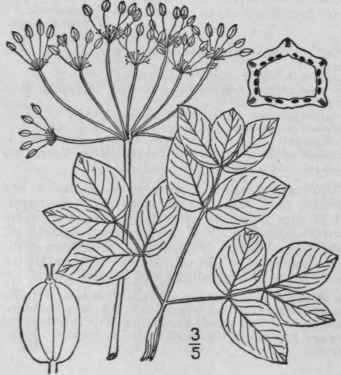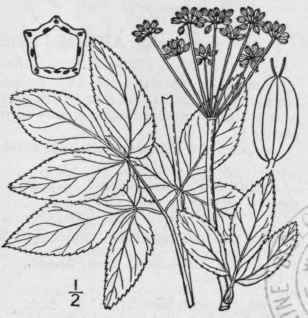24. Taenídia Drude In E. & P. Nat. Pflf. 38
Description
This section is from the book "An Illustrated Flora Of The Northern United States, Canada And The British Possessions Vol2", by Nathaniel Lord Britton, Addison Brown. Also available from Amazon: An Illustrated Flora of the Northern United States, Canada and the British Possessions. 3 Volume Set..
24. Taenídia Drude In E. & P. Nat. Pflf. 38
195. 1908.
A glabrous perennial herb, with 2-3-ternate leaves and compound umbels of yellow flowers. Involucre and involucels none. Calyx-teeth obsolete. Stylopodium broadly conic. Fruit oval, more or less compressed. Carpels obscurely 5-angled with slender equal distant ribs; oil-tubes numerous, 2-6 in the intervals. Seed-face flat or slightly convex. [Greek, with reference to the slender ribs.]
A monotypic genus.

1. Taenidia Integérrima (L.) Drude. Yellow Pimpernel
Fig. 3137
Smyrnium integerrimum L. Sp. Pl. 263.
1753:
Zizia integerrima DC. Rap. Pl. Jard Geneve 3: 7. 1830.
Pimpinella integerrima A. Gray, Proc. Am. Acad. 7: 345. 1868.
Taenidia integerrima Drude, loc. cit. 1908.
Erect, branched, glabrous, somewhat glaucous, 1°-3° high, slender. Leaves 2-3-ternate, the upper with short dilated petioles, the lower long-petioled; segments ovate, oval, or lanceolate, obtuse, or acutish and often mucronulate at the apex, entire, 6"-12" long; umbels slen-der-peduncled; rays 10-20, 2-4' long in fruit; flowers yellow; pedicels slender; fruit oval, glabrous, about 2" long.
In rocky or sandy soil, Quebec to North Carolina, Ontario, Minnesota, Arkansas and Mississippi. Ascends 4000 ft. in North Carolina. May-June. Golden alexanders.
25. ZÍZIA Koch, Nov. Act. Caes. Leop. Acad. 12: 129. 1825.
Perennial mostly glabrous herbs, with ternate or ternately compound leaves, or the basal ones undivided as in Thaspium, and compound umbels of yellow flowers, the central fruit of each umbellet sessile. Involucre none; involucels of several small bracts. Calyx-teeth prominent. Stylopodium none. Styles elongated. Fruit ovoid, or oblong, glabrous, or nearly so, somewhat flattened at right angles to the commissure, the ribs filiform, not winged; oil-tubes solitary in the intervals, with a small one under each rib. Seed-face flat. [In honor of I. B. Ziz, a Rhenish botanist.]
Three species, mainly distinguished from the Thaspia by their wingless fruit. Type species: Zizia aurea (L.) Koch.
Basal leaves 2-3-ternately compound. | ||
Rays of the umbel numerous, stout; fruit 2" long. | 1. | Z. aurea. |
Rays of the umbel 2-12, slender; fruit about 1" long. | 2. | Z. Bebbii. |
Basal leaves cordate, undivided; fruit about 1 1/2" long. | 3. | Z. cordata. |
1. Zizia Aùrea (L.) Koch. Early Or Golden Meadow-Parsnip
Fig. 3138
Smyrnium anreum L. Sp. Pl. 262. 1753.
Z. aurea Koch, Nov. Act. Caes. Leop. 12: 129. 1825.
Thaspium aureum var. apterum A. Gray, Man. Ed. 2, 156. 1856.
Zizia aurea obtusifolia Bissell, Rhodora 2: 225. 1900.
Erect, glabrous, branched, 1°-2 1/2° high. Basal and lower leaves long-petioled, 2-3-ternately compound, the segments ovate, or ovate-lanceolate, acute, acuminate or obtusish at the apex, 1'-2' long, sharply serrate; upper leaves shorter-petioled, ternate; rays of the umbels 9-25, stout, ascending, 1-2' long; fruit oblong, nearly 2" long, about 1 1/2" wide.
In fields, meadows, and swamps', New Brunswick to Ontario, Saskatchewan', South Dakota, Florida and Texas. April-June. Golden alex-anders. Wild parsley.

Continue to:


